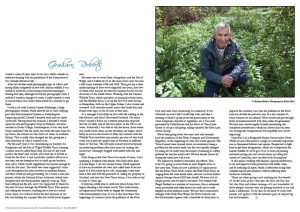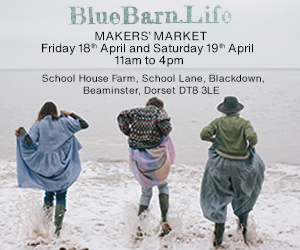
I grew up in Surrey and had a reasonable education at what was then a comprehensive. I then got an apprenticeship with Fairey Aviation and started training as an aerial photographer. During the 5 years of my apprenticeship, I did part-time OND and HND in industrial photography at Reading. After qualifying I was then lucky to spend two years working in Africa, starting in Nigeria and then in many countries along the West Coast. That’s over 50 years ago now, but it was very exciting, often as the youngest member of the crew.
I had always been interested in nature and conservation from my childhood. I inherited that from my dad, a farmer’s son, one of 10 children. He joined the RAF, spent the war as a p.o.w. in Germany having been shot down, but sadly the farm was too small to be viable, so it was sold after the war. The buyers were the Mills family—the ones with the famous actor John Mills. Visits to the farm in childhood had embedded my fascination with nature from a young age. There was a river running through it, called the Kent Water, where as children we’d collect lampreys, minnows, and small trout. I visited it some 30 years later. It was just a ditch—thanks to intensive farming with no protection of the watercourse it was virtually devoid of life.
After two further aerial photography trips to Africa, and having fallen completely in love with African wildlife, I was unable to travel for a year having contracted meningitis. During that time, although I loved my photography work, I realised I wanted a change of career. I really wanted to work in conservation, but I knew there would be a journey to get there.
I took a job with London Camera Exchange, a large photographic retailer, which allowed me to start studying part time Environmental Science at Southampton. Surprising myself, I found I enjoyed retail and was quite successful. Having done the research, I decided I would open my own photographic shop in Fareham, and later another in Ocean Village, Southampton. It was very hard work combined with the study, but when the time came for my thesis, the subject was the status of otters in southern Britain. That is really what changed my life, giving me a clear direction of what I wanted to do.
For the early years I was volunteering on Sundays for Hampshire and the Isle of Wight Wildlife Trust, running a nature reserve called Emer Bog. On one of the work parties, the chief exec visited, and asked me if I’d like to work for the Trust. I said I probably couldn’t afford to at the time, but my intention was to build up my business, then sell it, which would supplement my income enough to work for the trust. The chief exec then suggested I write a job description for otter recovery in southern Britain, and they would try and get funding. So, I wrote a one-year project, which the National Rivers Authority (which later morphed into the Environment Agency) took up. They then offered me the job, and I was supported by them for the next 20 years through the Wildlife Trust. That project, and selling my business, enabling me to live on a much lower salary, was without doubt the best decision of my life, but funding for a project like that would never happen now.
My remit was to cover Kent, Hampshire, and the Isle of Wight, and I walked all 26 of the main rivers over two and a half years, between 1986 and 1988. That gave me a clear understanding of how we’ve degraded out rivers, how few of them were natural, but the real surprise for me was my discovery of the Chalk Rivers. Working with the Vincent Wildlife Trust, which specialises in mammal conservation, and the Wildlife Trust, I set up the first two otter havens in Hampshire, both on the Upper Itchen. I also visited and surveyed 1100 riverside estates across the South East and found otter signs at just 26 sites at that time.
As a teenager I had fallen in love with hill walking in the lake District, and then I discovered Scotland. For many years I rented a house on a remote peninsular opposite the Isle of Mull, one of the best places in the UK to see otters. Eventually I was able to buy the house, from where you could watch otters on the shoreline, sea eagles, and if lucky an orca in the Sound of Mull. My contract with the Wildlife Trust involved nine months per year of very hard work, but it gave me quality time in Scotland at different times of the year. The 600-mile journey however became an increasing problem after forty years of visiting, the motorways seemingly clogged with traffic both day and night.
After living in the New Forest for nearly 30 years, I was spending a weekend with friends who lived down here in Lyme Regis. I saw my current home, which appeared to have an incredible sea view, and asked them to let me know if it ever came up for sale. Amazingly, some time later it did, and with the proceeds of selling my property in Scotland, and later the New Forest house, I was able to buy it some 11 years ago.
It took me a little time to settle into life in Lyme, but I began attending a few events run by Turn Lyme Green, an organisation which seeks to engage the community with environmental issues. It was at that time there were beginnings of concerns about the pollution of the River Lym and some basic monitoring was underway. It was obviously an issue I felt I could help with, and after a meeting at which I spoke about the privatisation of the water companies, the lack of regulation, etc, I was easily persuaded by Vicki Elcoate and Liz Davis of Turn Lyme Green to set up a sub-group, calling ourselves the River Lym Action Group.
We’ve been going about two years now and certainly have the attention of the Water Company and Government Regulator. At the beginning we were very much ignored. The Town Council were worried about our revelations being a problem for the tourist trade, but this very quickly changed by asking do we really want the tourists swimming in a filthy, polluted sea and the actual risks? We had already shown by testing the water how bad it was.
We realised we needed to formalise our efforts. This issue was going on everywhere in most English rivers at the same time. There are now a plethora of organisations like the Rivers Trust, River Action, the Wild Trout Trust, all singing from the same hymn sheet, and now we have Surfers Against Sewage whose CEO lives locally. We have a lot of people power, and we need to be heard. I’ve worked with Fergal Sharkey on a number of occasions, who is extremely vocal, passionate and really knows his stuff, and is really helpful on river pollution issues. We now have constructive dialogue with South West Water, the Town Council, and the Environment Agency with a timetable of three years to improve the situation. Last year the pollution in the River Lym was double the previous year. In a dry summer it’s worse because it’s less diluted. We’ve found and proved high levels of human-based E Coli after earlier disagreements. We have now started regular Riverfly monitoring (for streambed invertebrates) which has shown that our river was ecologically compromised, but hopefully now slowly improving.
Lyme Bay is in a designated Marine Conservation Zone, which are areas that protect a range of nationally important, rare or threatened habitats and species. People had to fight hard to get these designations, which are so important for marine wildlife. If we’ve got 10 or 12 rivers all pouring untreated sewage into the coastal waters just along this stretch of Lyme Bay, how can they be fit for purpose?
It also means working with farmers, riparian landowners, to try and improve water protection with buffer strips, and by reducing silt input, which is effectively losing their valuable topsoil and nutrients, without affecting their businesses adversely.
There are other groups now working for the benefit of all the local rivers—the Axe, the Brit, the Kit, the Sid, the Char and others coming—it’s just wonderful, all these people, citizens who are getting involved to try and make a difference. To do that we all need to work with people, not against, with the ultimate goal of improving our environment.




